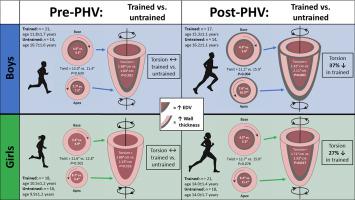当前位置:
X-MOL 学术
›
J. Am. Soc. Echocardiog.
›
论文详情
Our official English website, www.x-mol.net, welcomes your feedback! (Note: you will need to create a separate account there.)
Adaptation of Left Ventricular Twist Mechanics in Exercise-Trained Children Is Only Evident after the Adolescent Growth Spurt
Journal of the American Society of Echocardiography ( IF 6.5 ) Pub Date : 2023-12-04 , DOI: 10.1016/j.echo.2023.11.024 Dean R. Perkins , Jack S. Talbot , Rachel N. Lord , Tony G. Dawkins , Aaron L. Baggish , Abbas Zaidi , Orhan Uzun , Kelly A. Mackintosh , Melitta A. McNarry , Stephen-Mark Cooper , Rhodri S. Lloyd , Jon L. Oliver , Rob E. Shave , Mike Stembridge
Journal of the American Society of Echocardiography ( IF 6.5 ) Pub Date : 2023-12-04 , DOI: 10.1016/j.echo.2023.11.024 Dean R. Perkins , Jack S. Talbot , Rachel N. Lord , Tony G. Dawkins , Aaron L. Baggish , Abbas Zaidi , Orhan Uzun , Kelly A. Mackintosh , Melitta A. McNarry , Stephen-Mark Cooper , Rhodri S. Lloyd , Jon L. Oliver , Rob E. Shave , Mike Stembridge

|
The extent of structural cardiac remodeling in response to endurance training is maturity dependent. In adults, this structural adaptation is often associated with the adaptation of left ventricular (LV) twist mechanics. For example, an increase in LV twist often follows an expansion in end-diastolic volume, whereas a reduction in twist may follow a thickening of the LV walls. While structural cardiac remodeling has been shown to be more prominent post–peak height velocity (PHV), it remains to be determined how this maturation-dependent structural remodeling influences LV twist. Therefore, we aimed to (1) compare LV twist mechanics between trained and untrained children pre- and post-PHV and (2) investigate how LV structural variables relate to LV twist mechanics pre- and post-PHV. Left ventricular function and morphology were assessed (echocardiography) in endurance-trained and untrained boys ( = 38 and = 28, respectively) and girls ( = 39 and = 34, respectively). Participants were categorized as either pre- or post-PHV using maturity offset to estimate somatic maturation. Pre-PHV, there were no differences in LV twist or torsion between trained and untrained boys (twist: = .630; torsion: = .382) or girls (twist: = .502; torsion: = .316), and LV twist mechanics were not related with any LV structural variables ( > .05). Post-PHV, LV twist was lower in trained versus untrained boys ( = .004), with torsion lower in trained groups, irrespective of sex (boys: < .001; girls: = .017). Moreover, LV torsion was inversely related to LV mass (boys: = −0.55, = .001; girls: = −0.46, = .003) and end-diastolic volume (boys: = −0.64, < .001; girls: = −0.36, = .025) in both sexes. A difference in LV twist mechanics between endurance-trained and untrained cohorts is only apparent post-PHV, where structural and functional remodeling were related.
中文翻译:

运动训练儿童的左心室扭转机制的适应只有在青春期生长突增后才明显
耐力训练引起的结构性心脏重塑的程度取决于成熟度。在成人中,这种结构适应通常与左心室 (LV) 扭转力学的适应相关。例如,左心室扭转的增加通常伴随着舒张末期容积的扩张,而扭转的减少可能伴随着左心室壁的增厚。虽然结构性心脏重塑已被证明在峰后高度速度 (PHV) 中更为突出,但这种依赖于成熟的结构性重塑如何影响左心室扭转仍有待确定。因此,我们的目的是(1)比较经过训练和未训练的儿童在 PHV 前后的 LV 扭转力学,以及(2)研究 LV 结构变量与 PHV 前后的 LV 扭转力学之间的关系。对经过耐力训练和未训练的男孩(分别 = 38 和 = 28)和女孩(分别 = 39 和 = 34)进行左心室功能和形态评估(超声心动图)。使用成熟补偿来估计体细胞成熟度,将参与者分为 PHV 前或 PHV 后。 PHV 前,受过训练和未训练的男孩(扭转:= .630;扭转:= .382)或女孩(扭转:= .502;扭转:= .316)之间的 LV 扭转或扭转没有差异,并且 LV 扭转力学与任何 LV 结构变量均无关 (> .05)。 PHV 后,受过训练的男孩的 LV 扭转低于未经训练的男孩 (= .004),受过训练的组的扭转较低,无论性别如何(男孩:< .001;女孩:= .017)。此外,左心室扭转与左心室质量(男孩:= -0.55,= .001;女孩:= -0.46,= .003)和舒张末期容积(男孩:= -0.64,< .001;女孩:= −0.36, = .025) 男女皆宜。经过耐力训练和未训练的人群之间左心室扭转力学的差异仅在 PHV 后才明显,其中结构和功能重塑是相关的。
更新日期:2023-12-04
中文翻译:

运动训练儿童的左心室扭转机制的适应只有在青春期生长突增后才明显
耐力训练引起的结构性心脏重塑的程度取决于成熟度。在成人中,这种结构适应通常与左心室 (LV) 扭转力学的适应相关。例如,左心室扭转的增加通常伴随着舒张末期容积的扩张,而扭转的减少可能伴随着左心室壁的增厚。虽然结构性心脏重塑已被证明在峰后高度速度 (PHV) 中更为突出,但这种依赖于成熟的结构性重塑如何影响左心室扭转仍有待确定。因此,我们的目的是(1)比较经过训练和未训练的儿童在 PHV 前后的 LV 扭转力学,以及(2)研究 LV 结构变量与 PHV 前后的 LV 扭转力学之间的关系。对经过耐力训练和未训练的男孩(分别 = 38 和 = 28)和女孩(分别 = 39 和 = 34)进行左心室功能和形态评估(超声心动图)。使用成熟补偿来估计体细胞成熟度,将参与者分为 PHV 前或 PHV 后。 PHV 前,受过训练和未训练的男孩(扭转:= .630;扭转:= .382)或女孩(扭转:= .502;扭转:= .316)之间的 LV 扭转或扭转没有差异,并且 LV 扭转力学与任何 LV 结构变量均无关 (> .05)。 PHV 后,受过训练的男孩的 LV 扭转低于未经训练的男孩 (= .004),受过训练的组的扭转较低,无论性别如何(男孩:< .001;女孩:= .017)。此外,左心室扭转与左心室质量(男孩:= -0.55,= .001;女孩:= -0.46,= .003)和舒张末期容积(男孩:= -0.64,< .001;女孩:= −0.36, = .025) 男女皆宜。经过耐力训练和未训练的人群之间左心室扭转力学的差异仅在 PHV 后才明显,其中结构和功能重塑是相关的。



























 京公网安备 11010802027423号
京公网安备 11010802027423号